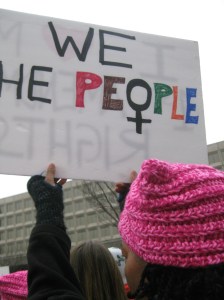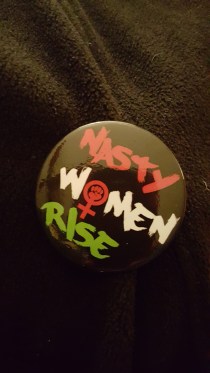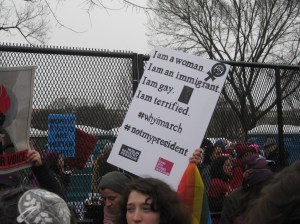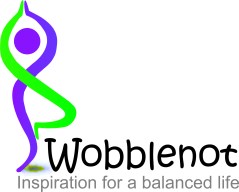Fury and helplessness had settled in after the Presidential election. People talked about “surviving” the next four years until 2020. I considered the possibility of an America I wouldn’t recognize. When word got around about the Women’s March, nine of us committed to go. My niece, Julia, and her two friends traveled from Maine and New York City.


We joined more than half a million like-minded Americans at the Women’s March in the Nation’s Capital for “The Resistance.” Finally, an outlet! — because 10 weeks is a long time to be so furious.


I thought about what my sign would say, and my mind kept going to the Constitution. I decided on “We The People” and “I Love My 1st Amendment Rights.” They weren’t original ideas because this theme was playing for others, too.
After every other election in my lifetime, the new (or incumbent) President gave a unifying message. With this President, I am among the majority of voters he refers to as “the other side,” and to whom he continually gloats that he “won big.” This is my country, too, and the leadership he assumed requires him to address that — and not in a vengeful way.






We The People were part of something big. There was a mood of cohesiveness and people were friendly. There were huge crowds at the Metro stations and packed trains from end to end. We emerged from Metro at the Building Museum and fell in with the throngs, working our way to a spot within sight and sound of the rally’s speakers.


We gathered. We chose LOVE over hate. We demonstrated love for our country. We demonstrated concern that this President would comb over women’s issues. We wore pussy hats. We marched. We wanted to reclaim the soul of our country. We were “Nasty Women!” We chanted and affirmed: “This is what democracy looks like! “


Hope, intelligence, humor, passion, and the power of women and diversity were on display at the 2017 Women’s March. Messages that made me LOL: “If my uterus could shoot bullets, the government wouldn’t regulate it.” Another was “Free Melania.” And yet another, “In 2017, I can’t believe I’m still protesting this shit.” Don’t you love candor?





This March was an exercise of First Amendment rights — that precious bundle of five rights about freedom of expression.
“Congress shall make no law respecting an establishment of religion, or prohibiting the free exercise thereof; or abridging the freedom of speech, or of the press; or the right of the people peaceably to assemble, and to petition the Government for a redress of grievances.”
People have sought asylum in countries that have these rights. We can’t take them for granted. In my opinion, our rights are under attack or, at the very least, misunderstood.
Freedom of Religion. For years, politicians have been on the defensive about claims that they’re not Christian or not Christian enough. While Christianity has influenced American society, the U.S. was not established as a Christian nation. The relevance of Bible-citing blew up with this President’s candidacy. The Republican Party didn’t give a damn. How you worship, which deity you worship, or whether you worship at all is a personal right.
One of the performers at the March was a young Muslim named Alia Sharrief. She’s no novice to activism. Her performance was apropos for “The Resistance.” Here’s a sample of her art: https://www.youtube.com/watch?v=QZJub-2fYho
Over the last year, I have heard some astonishing anti-Muslim sentiments from people I considered smart! Wearing a hijab, a Muslim woman is especially vulnerable because the garb marks her as Muslim. Her issue is our issue. We need to care.
These signs showed the intersectionality of human rights issues.



Freedom of Speech. This precious right has some restrictions — like, not inciting violence; or committing slander about others by spreading lies, falsehoods, or alternative facts; or uttering certain profanity. Whether a statement is actually slander also depends on whether the target is a private person or public figure. You may recall that Candidate Trump did a lot of name-calling: “Lyin’ Ted” (Senator Ted Cruz), “Little Marco” (Senator Marco Rubio), and “Crooked Hillary” and “Nasty Woman” (Secretary Hillary Clinton). It was ugly behavior, but it was his right.
Freedom of speech includes actions and gestures. Colin Kaepernick, for instance, took the knee during the National Anthem to protest the treatment of Blacks in the U.S. People burned his football jersey, threatened to boycott the NFL, blah blah blah…. They said he should have protested some other way. But, it is Kaepernick’s right to express protest any way he wants (as long as it is not illegal), and how he does it is not subject to another person’s sensibilities. Kaepernick risked all to be a high-profile activist. He gives back to the community with his I Know My Rights Camp for kids, where they learn about their civic duty to be engaged and opinionated.

Freedom of the press. This freedom is definitely under attack. Freedom of the press is about access to, publication and distribution of information without government intervention. It’s also important that media outlets not be owned by only a few companies. Diversity of information sources is important for diversity of thought.
Somewhere in the world are media outlets that are government-owned or controlled, like Russia. Some governments create propaganda and offer alternative facts, like Russia. I thought of an undesirable scenario based on the dystopian society in The Hunger Games called Panem. There, the Capitol controlled its citizens through isolation, harsh policing (called peacekeeping), and propaganda.
Right to assemble. Black Lives Matter (BLM), for example, has held protests and demonstrations in a movement that is growing around the world. The movement’s very name was rabidly criticized by the ex-mayor of NY and a Wisconsin sheriff at the Republican National Convention. Both dismissed BLM with the counterclaim that all lives matter. The right to assemble means that people have the right to organize demonstrations and call their organization or movement any damn thing they want.




The Women’s March embraced BLM issues, too. Janelle Monae had the crowd do a call-and-response during her anthem against police brutality, “Hell You Talmbout.” One mother called out her child’s name: “Sandra Bland!” The crowd roared back: “SAY HER NAME!” Another mother called out her child’s name: “Freddie Gray!” The crowd roared back: “SAY HIS NAME!” This roll call acknowledgment of a mother’s loss was simply powerful.
Right to petition the Government with grievances. Speakers at the Women’s March urged the crowd to exercise this right with their local representatives and members of Congress. This Constitutional right allows a slew of actions. We can lobby; write letters; and contact our representatives in Congress (or any level of government). We can testify before tribunals; file lawsuits; collect signatures for ballot initiatives; and engage in peaceful protests and picketing — all to influence government action. This would also include whistle-blowing, especially if you’re a Federal government employee.
When we returned home from the March, we watched the news. We were awed that over 600 marches or rallies had occurred that day in all 50 states. Approximately 2.9 million people participated! What’s more, protests and women’s marches had also been held that day all over the world.
This is what democracy looks like!






















